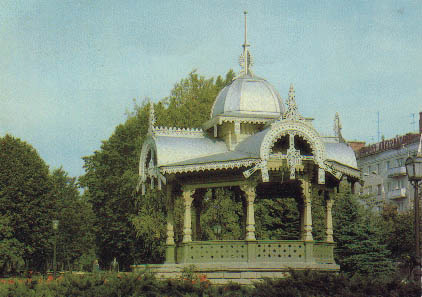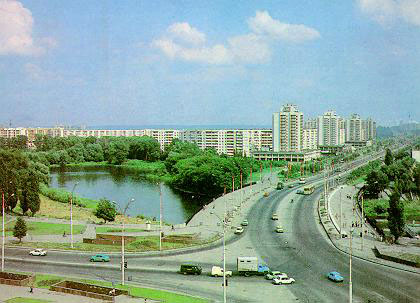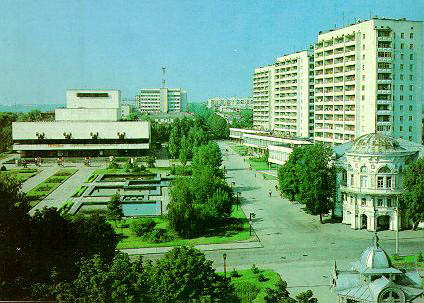Sumy City (which is also the capital of the
region)
is situated on the banks of the Pslo river and its tributaries Sumka and
Strilky. Population: about 300,000. Telephone code: 380-5422.
The settlement of the region began approximately 15,000 years ago. During
the Bronze age the area was inhabited by the ancient Slavic farming and
cattle-breeding tribes. With the discovery of iron ore in the Dnipro river
region (8th cent. B.C.), almost all the lands were settled by Scythian
farmers. In the 7th-10th cent. the area was inhabited by the Slavic Siveriany
tribes.
From the 9th cent. the Sumy lands were part of Kyivan Rus'-Ukraine,
namely the Pereyaslav and the Chernihiv principalities, and in the mid-12th
cent., part of Novhorod-Siversky principality. During this time many cities
were built. Fierce battles among the various princes were fought, especially
during the 1140s. The Polovtsian tribes took advantage of these destructive
wars and launched attacks on the principalities. Their unsuccessful crusade
against the Novhorod-Siversky Prince Ihor and other princes, is the subject
of the oldest Ukrainian literary epic "The Lay of Ihor's Campaign." In
1239 the Tatars destroyed many ancient cities in the land. The Tatar Khans
treated the population cruelly and much of the population perished at their
hands.
In the 1350s-60s the Lithuanian principality captured a major part of
the present-day Sumy region. According to the peace treaty of 1503, which
ended the war with Lithuania, almost all the Chernihiv and Siversk territories
became part of the Muscovite state. The city of Putyvl became an important
border point. In the early 17th cent. Polish incursions in the area intensified,
accompanied by harsh colonial policies and violence which was directed
at the population of the occupied Ukrainian lands.
Sumy city was established in 1655. Scholars have
identified it as the city of Lypetsk as de- scribed in the chronicles.
The population suffered greatly from various invaders. In 1656-58 one
of the mightiest fortresses in Slobozhanshchyna was built here. In 1658
Sumy became the center of the Slobidsky Kozak Regiment, which distinguished
itself in battles of 1677-78.
During the 18th-19th cent. trades and industrial enterprises flourished
here. After regimental rule was abolished, the Kozak regiment became a
Hussars' regiment. The abolition of serfdom in 1861 helped to spur industrial
development. Before the First World War there were nearly forty enterprises
in the city.
Many distinguished individuals are connected with the city. The Ukrainian
philosopher and poet H. Skovoroda visited Sumy many times in the 18th cent.
T. Shevchenko visited Sumy in 1859. The writers B. Hrinchenko and V. Korolenko,
as well as the composer Peter Tchaykovsky visited Sumy on numerous occasions.
Sumy in pictures
Symbol of the city
 Bridge over Psel (Pslo) river
Bridge over Psel (Pslo) river
 Theater Square
Schepkin theater (on the left side) and regional
museum (on the right)
Theater Square
Schepkin theater (on the left side) and regional
museum (on the right)
 VOSKRESENSKA (RESURRECTION) CHURCH 1702. A two tiered structure
is with a picturesque interior. One of the most outstanding monuments of
the Slobozhanska school Ukrainian Baroque architecture, with three cupolas;
stone. The church houses a Museum of Decorative and Applied Art.
VOSKRESENSKA (RESURRECTION) CHURCH 1702. A two tiered structure
is with a picturesque interior. One of the most outstanding monuments of
the Slobozhanska school Ukrainian Baroque architecture, with three cupolas;
stone. The church houses a Museum of Decorative and Applied Art.
BELL TOWER OF THE VOSKRESENSKA (RESURRECTION) CHURCH,
1906. Built in the Baroque style; a brick structure.
 SPASO-PREOBRAZHENSKY (TRANSFIGURATION) CATHEDRAL, 1776-88.
The 56m bell tower forms part of the architectural composition. A single-domed
four column structure is combining elements of the Renaissance, Baroque
and Classical styles. The sculptured details of the cornices are masterfully
executed; the walls are decorated in marble. The iconostasis is sculpted
of white marble and malachite. The interior is decorated with beautiful
paintings of biblical scenes by the artist V. Makovsky. Some of the paintings
are exhibited in the Municipal Art Museum.
SPASO-PREOBRAZHENSKY (TRANSFIGURATION) CATHEDRAL, 1776-88.
The 56m bell tower forms part of the architectural composition. A single-domed
four column structure is combining elements of the Renaissance, Baroque
and Classical styles. The sculptured details of the cornices are masterfully
executed; the walls are decorated in marble. The iconostasis is sculpted
of white marble and malachite. The interior is decorated with beautiful
paintings of biblical scenes by the artist V. Makovsky. Some of the paintings
are exhibited in the Municipal Art Museum.
 TROYITSKY (HOLY TRINITY) CATHEDRAL, 1901-14. Built in the
Classical style with Baroque elements in its decor. Today it houses a concert
hall for organ and chamber music of the Regional Philharmonic, as well
as a Sculpture Museum.
TROYITSKY (HOLY TRINITY) CATHEDRAL, 1901-14. Built in the
Classical style with Baroque elements in its decor. Today it houses a concert
hall for organ and chamber music of the Regional Philharmonic, as well
as a Sculpture Museum.






